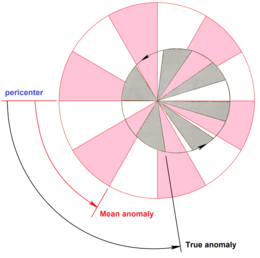
Back زاوية وسط الشذوذ Arabic Anomalía media AST Средна аномалия Bulgarian Anomalia mitjana Catalan Střední anomálie Czech Μέση ανωμαλία Greek Meza anomaliangulo Esperanto Anomalía media Spanish Batezbesteko anomalia Basque آنومالی متوسط Persian

| Part of a series on |
| Astrodynamics |
|---|
In celestial mechanics, the mean anomaly is the fraction of an elliptical orbit's period that has elapsed since the orbiting body passed periapsis, expressed as an angle which can be used in calculating the position of that body in the classical two-body problem. It is the angular distance from the pericenter which a fictitious body would have if it moved in a circular orbit, with constant speed, in the same orbital period as the actual body in its elliptical orbit.[1][2]
- ^ Montenbruck, Oliver (1989). Practical Ephemeris Calculations. Springer-Verlag. p. 44. ISBN 0-387-50704-3.
- ^ Meeus, Jean (1991). Astronomical Algorithms. Willmann-Bell, Inc., Richmond, VA. p. 182. ISBN 0-943396-35-2.
© MMXXIII Rich X Search. We shall prevail. All rights reserved. Rich X Search